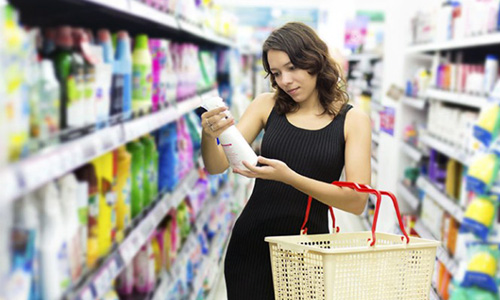

When you go shopping, how do you know what products won’t make you sick or trash the planet? It’s pretty confusing, since so many companies use words like “natural” or “safe” or “green,” even though these descriptions don’t actually mean anything.
Fortunately, independent organizations are setting standards that motivate companies to eliminate use of toxic chemicals in their manufacturing process. Companies that meet the standards earn the right to put a label on their packaging signifying the product is safe to use.
Here are five labels you can look for that will help you stay safe when you shop:
1. MADESAFE
MADESAFE screens products for endocrine disruptors, BPA, phthalates, developmental toxins, heavy metals, fire retardants, pesticides, herbicides, toxic solvents, harmful volatile organic compounds and GMOs. It screens cosmetics, home goods, personal care items, condoms and mattresses for starters. Virtually any consumer product can be evaluated to determine that goods are made entirely from ingredients that are not known or suspected to harm human health. Once a product achieves MADESAFE designation, it can go through a lab testing process to ensure that it is truly non-toxic. MADESAFE examines products already on store shelves, but also provides guidelines to companies as they are formulating new products.
2. GreenScreen for Safer Chemicals
GreenScreen offers a tool to identify known chemicals “of high concern to human health and the environment.” The GreenScreen List Translator ranks chemicals based on more than 40 hazard lists developed by national and international scientific organizations as well as non-profit research institutes. It’s particularly useful to help companies identify which chemicals they need to phase out of their products. Right now, GreenScreen is being used by software manufacturers, electronics manufacturers and textile and apparel companies like Nike.
3. GreenSeal
This independent non-profit organization has developed a certification process to ensure that a product meets meaningful performance, health and environmental criteria. Manufacturers use it to help eliminate toxic chemicals in their products. Consumers can look for the seal on household cleaners, carpet cleaners, construction materials, paints and coatings, printing and writing paper, hand soaps and cleaners, even paper towels, napkins and tissue paper. Hotels and restaurants may be Green Seal-certified as well. Some GreenSeal certified cleaning products you might recognize include Green4Kleen, Natures Solution, Sustainable Earth by Staples Glass Cleaner and Rhino Pet Stain and Odor Remover.
4. EWG Verified
Environmental Working Group (EWG) has been a pioneer in raising awareness about toxic ingredients in personal care products. Their new label verifies that products do not contain ingredients on the group’s “unacceptable” list, which they describe as meaning ingredients that post health, ecotoxicity and/or contamination concerns. Products must fully disclose all ingredients on their label, including ingredients used in fragrance. EWG Verified products must also follow the European Union’s labeling guidelines for nanomaterials used in cosmetics. Among the companies that are EWG Verified are Beauty Counter cosmetics, MyChelle Dermaceuticals, Rejuva Minerals and Jouve serum.
5. Campaign for Safe Cosmetics
The Campaign for Safe Cosmetics doesn’t have a label per se. However, it’s compiled a comprehensive database you can refer to whenever you’re buying make-up or nail polish. Start by reviewing the group’s list of Chemicals of Concern. Then download their tips on ingredients to avoid in conditioner, lipstick, hair dye, fragrance, sunscreen, skin lighteners, moisturizer and nail polish.
YOU MIGHT ALSO LIKE
5 Powerful Skin Care Products Found Right in Your Kitchen
Make Sure the Products You’re Putting on Your Body Are Not Toxic
Teen Girls See Big Drop in Chemical Exposure With Switch in Cosmetics

 233k
233k  41k
41k  Subscribe
Subscribe 